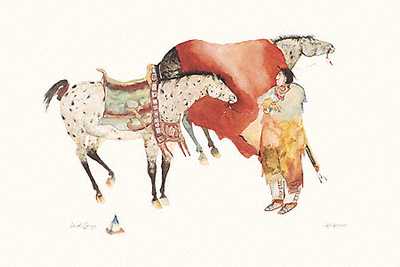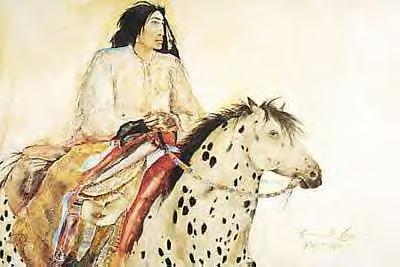|
 A chocolate
brown horse with white speckles on his rump prances inside a small arena near the Nez Perce Indian Reservation
town of Lapwai, population 932. The animal resembles an appaloosa, a horse historically associated with the Nez
Perce, except it's taller and a little leaner. A chocolate
brown horse with white speckles on his rump prances inside a small arena near the Nez Perce Indian Reservation
town of Lapwai, population 932. The animal resembles an appaloosa, a horse historically associated with the Nez
Perce, except it's taller and a little leaner.
"This is what we wanted for the tribe," says Rudy Shebala, a man under a black cowboy hat who runs the
Nez Perce Indian Tribe's horse breeding program.
The Nez Perce developed the appaloosa breed from wild mustangs. The tribe lost its mounts in the Nez Perce War
of 1877 and never regained its horse culture.
The light-footed war horses were scattered and the breed was lost.
Now, the tribe has reclaimed its place among horsemen by creating a new line called the Nez Perce Horse. It blends
the appaloosa with traits from a lean Central Asian war horse called akhal-teke.
The breeding program was aided by a Minnesota breeder who donated four tall akhal-teke horses to the tribe in 1994.
In the spring of 1995, 24 colts were born. Dozens more followed. The youngest generation is now almost fully grown.
The Nez Perce aren't ready to brag yet, because the breed is so young, Shebala said. But everything looks good
so far.
"Dreams are scary when they start coming true," Shebala said. "We have these awesome horses now."
They also have the attention of the national media.
 The Nez Perce have always captured the imaginations of Western culture buffs, because of the appaloosa
and Chief Joseph's famous speech, "I will fight no more forever." The Nez Perce have always captured the imaginations of Western culture buffs, because of the appaloosa
and Chief Joseph's famous speech, "I will fight no more forever."
The historical significance of the tribe reuniting with its horse culture has pushed the Nez Perce to the forefront
of popular culture.
The New York Times and Sunset Magazine have written stories about the tribe. Cable channels like A&E, Outdoor
Channel and NW Cable news have all featured the Nez Perce horse program.
Interest has been increasing as the program matures. Visitors driving through the area frequently spot the horses
grazing in pens.
"Hi, we're here to see the horses," says a woman leading two others.
Shebala's assistant waves them toward the pen where colts are kept.
With two full-time employees and 80 horses, the program's 1999 budget was $111,000 -- funded by the tribe, Shebala
said. He recently sold a horse to a Virginia man for $5,000.
Shebala wants to develop a thriving horse business while bringing a horse culture back to the people.
Helping him out during the summer are 10 teenagers who are part of the tribe's youth program.
Carl Ray Powaukee, 15, keeps a horsehair braid on his hat, a gift from a woman he helped once while riding a rough
trail.
 "I like riding horses," Powaukee said. "I'm just usually out here all the time,
riding horses or feeding and watering them." "I like riding horses," Powaukee said. "I'm just usually out here all the time,
riding horses or feeding and watering them."
Six teens haul hay into bins, clean out stalls and practice their riding skills while Shebala watches.
Many are also part of the Young Horseman project for youth age 14-21 who are trained to care for horses as their
ancestors did.
In July, they rode with the Salish and Kootenai Indians while repairing trails on the Montana route the Nez Perce
used during the 1877 war.
"It's really wonderful to see these young people," said Otis Halfmoon, an unofficial tribal historian
and manager at the Nez Perce National Historical Park. "There's great pride in their eyes when you visit with
them."
And with so many young people getting involved again with horses, their parents and grandparents are learning horsemanship
with other reservation groups like the Chief Joseph Foundation and Nez Perce Appaloosa Club.
And along with the renewed interest is a return of old regalia and traditional ceremonial wear for horses. Halfmoon
recently saw a Nez Perce horse dressed in a cornhusk trapping, the kind of work no one does anymore, he said.
"A lot of Nez Perce families, they save and put away a lot of the regalia. They must have put it in a trunk
and they decided to bring it out again," Halfmoon said. "To see these old things come back makes me feel
good."
It ensures the culture will never die, he said.
Find out more:
Nez Perce Horse Registry
http://www.nezpercehorseregistry.com/
|